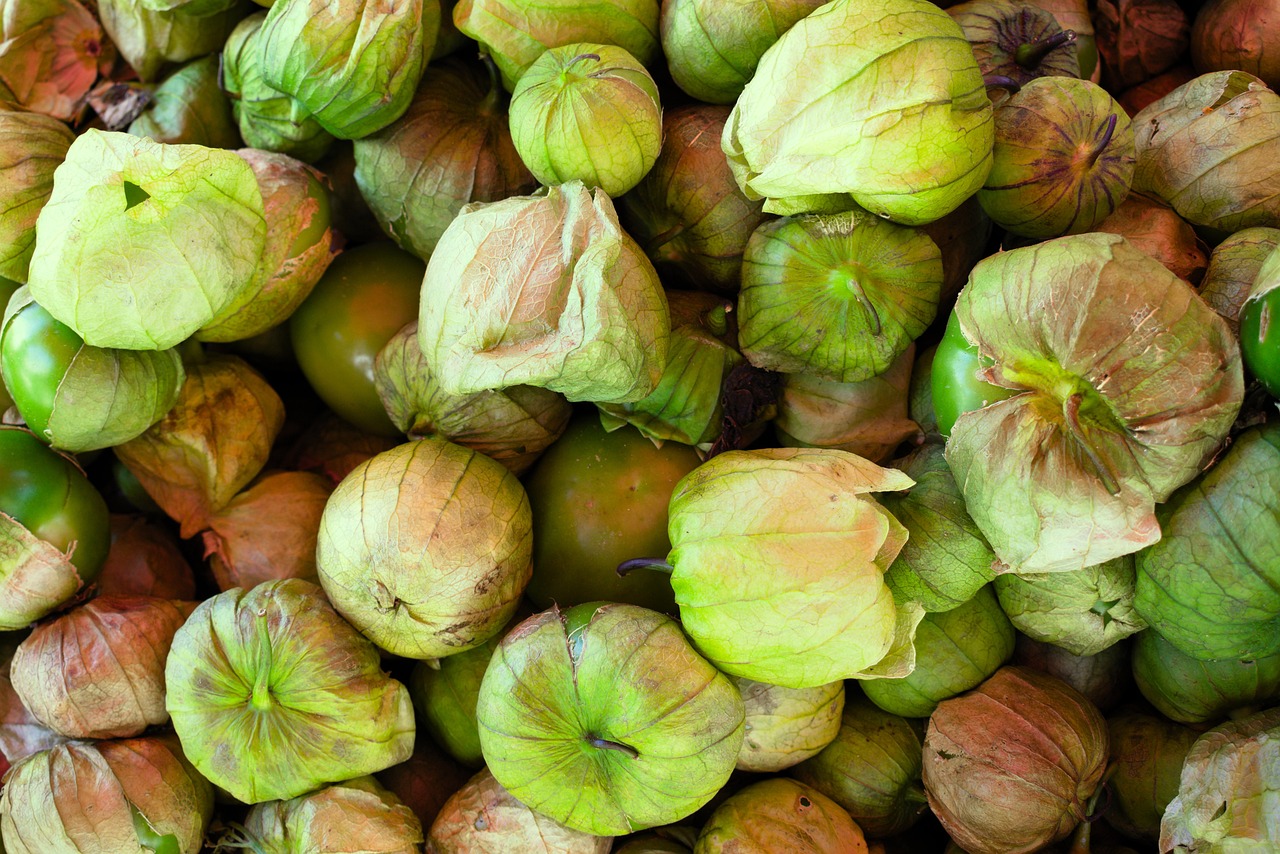Contents
Understanding the Tomatillo

Tomatillos are small green fruits surrounded by a papery husk. Botanically, they are a member of the nightshade family, related to tomatoes and eggplants. Their scientific name is Physalis philadelphica.
Other common names for tomatillos include Mexican husk tomato, jamberry, miltomate, tomatillo verde, tomate milpero, tomate de cáscara, or tomate de fresadilla.
Tomatillos originated in Mexico and were a staple of the Aztec diet. Spanish conquistadors adopted them and brought tomatillos back to Europe. They remain an integral part of Central American and Mexican cuisine today.
Selecting and Preparing Tomatillos
When selecting tomatillos, look for fruits that are firm and bright green, as ripening causes them to turn yellow. The papery husk should be intact and not torn. Avoid any fruits that are overly soft or mushy.
To prepare tomatillos:
- Remove the husk by peeling it back and rinsing the fruit well.
- The sticky surface should be washed off before use.
- Remove the stem and core before cooking.
- Chop or slice as needed for recipes.
Nutrition and Health Benefits
Tomatillos are highly nutritious, low in calories, and packed with beneficial phytonutrients. Some of the key nutrients and health benefits include:
- Excellent source of vitamin C and antioxidants.
- Contain digestive enzymes like pepsin and papain.
- Provide immune-boosting compounds like quinine and lycopene.
- Aid in reducing inflammation and risk of chronic diseases.
- Support heart health by lowering LDL cholesterol.
- Low glycemic index helps regulate blood sugar.
See more : How to Make Cornstarch | Step-by-Step Guide
With this impressive nutritional profile, enjoying tomatillos regularly promotes overall wellbeing.
Storing Tomatillos
Tomatillos can be stored:
- At room temperature for up to two weeks.
- In the refrigerator for 2-3 weeks in a plastic bag.
- Frozen whole or sliced for 6-8 months.
- Canned or jarred tomatillos keep for 1 year sealed.
For best flavor and texture, use fresh tomatillos within a few days of purchasing.
Cooking With Tomatillos
To cook with tomatillos, you can try various recipes that highlight their tangy flavor and vibrant green color. Here are some common methods to work with tomatillos based on the provided sources:
- Roasting: Most recipes call for roasting tomatillos before combining them with other ingredients. You can roast them in the oven at 400°F for about 15 minutes until they wrinkle and turn army green in color.
- Salsa Verde: Salsa Verde is a popular use for tomatillos. You can make it by blending cooked tomatillos with onion, jalapeño, lime, and cilantro. The tomatillos can be cooked by boiling them, broiling them in the oven, or pan-roasting them.
- Recipes: There are numerous recipes you can try with tomatillos, such as Roasted Tomato and Tomatillo Salsa, Chicken Burritos with Avocado Salsa Verde, Enchiladas Suizas, and more.
- Storage: Store fresh tomatillos in the fridge, in their husks, where they can keep for weeks at a time.
By following these methods and recipes, you can easily incorporate tomatillos into your cooking and enjoy their unique flavor in dishes like salsas, enchiladas, and more.
Recipe: Easy Fried Tomatillos
Fried tomatillos make a fun finger food or snack. Their interior remains tender while the exterior gets crispy.
Ingredients:
- 5 medium tomatillos, husked, rinsed and patted dry
- 1/2 cup all-purpose flour
- 1 teaspoon smoked paprika
- 1/2 teaspoon salt
- 1/4 teaspoon pepper
- Vegetable oil for frying
Instructions:
- Mix together flour and spices in a shallow bowl.
- Slice tomatillos into 1/4-inch rounds.
- Dredge slices in flour mixture until fully coated on both sides.
- Heat 1/2 inch oil in skillet over medium-high heat.
- Fry slices in batches 2-3 minutes per side until golden brown.
- Transfer to paper towel-lined plate to drain excess oil.
- Sprinkle with salt and serve warm.
Advanced Techniques
See more : Easy guide to delicious meals on your Blackstone Griddle
More advanced cooks can try incorporating tomatillos into:
- Ceviches – for a tangy twist on the lime-based seafood dish.
- Quesadillas – slice and sandwich between tortillas with cheese.
- Enchilada sauce – blend into a flavorful green sauce.
- Chutneys – puree as a condiment for meats, cheeses, crackers.
- Jams – simmer into a sweet-tart spread.
The possibilities are endless for imaginative chefs!
Common Mistakes
It’s important to avoid some common pitfalls when cooking with tomatillos:
- Don’t overcook. Their flavor becomes bitter and mushy.
- Prevent burning the pan sauce by monitoring heat.
- Be careful not to under-season. Tomatillos need added salt, spices.
- Avoid canned tomatillos, which lack fresh flavor.
- Don’t waste the juice! It has great tangy flavor for sauces.
Flavor Pairings
Tomatillos’ tanginess pairs wonderfully with these seasonings and ingredients:
- Cilantro, epazote, cumin – classic Mexican herbs and spices
- Avocado, pepitas – for balance with creaminess, crunch
- Chicken, shrimp – play up their versatility as a meat seasoning
- Corn, hominy – highlights tomatillo’s sweetness
- Queso fresco, feta – bright, briny cheeses cut richness
Don’t limit tomatillos just to salsa verde. Get creative with complementary flavors!
Compared to Green Tomatoes
While they look somewhat similar raw, there are some key differences:
- Tomatillos have a papery husk and sticky surface.
- They are always green when ripe, not red.
- More tart and bright in flavor compared to tomatoes.
- Denser flesh and fewer seeds inside.
- Can be used when firm for crisp texture.
However, for cooked applications like sauce or stew, green tomatoes can work as a substitute in a pinch. Just be prepared for it to be less tangy in flavor.
Conclusion
Beyond just being the base of salsa verde, vibrant tomatillos can transform tacos, stir fries, sandwiches, chutneys, and many other dishes. Their pleasant acidity and tropical fruit flavor profile make tomatillos extremely versatile. With proper selection, storage, preparation, and cooking techniques, anyone can take advantage of tomatillos in their kitchen. What will you make with tomatillos next? Share your creations and experiences cooking with this amazing ingredient!
For even more inspiration, check out online culinary lessons focused on Mexican cuisine and creative ways to use tomatillos. With the right know-how, you can become a tomatillo pro in no time. Now go expand your palate with new tomatillo dishes!
Chef Angelo Landi has been in the culinary industry for over 20 years, and he has spent the last six of those developing the menu for Coal Vines. His favorite pizza on the menu is the Spicey Meatball, which is made with spicy sausage, pepperoni, and calabrese salami. When he’s not in the kitchen cooking up a storm, Chef Angelo enjoys spending time with his wife and two young children.








